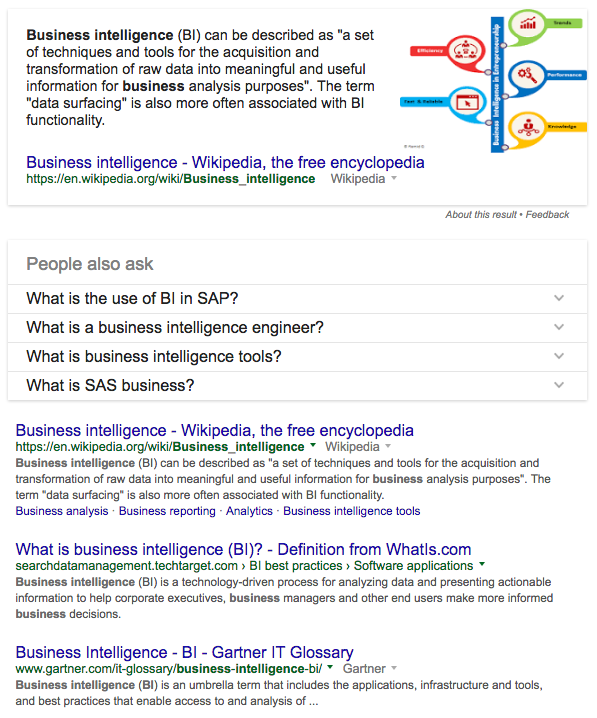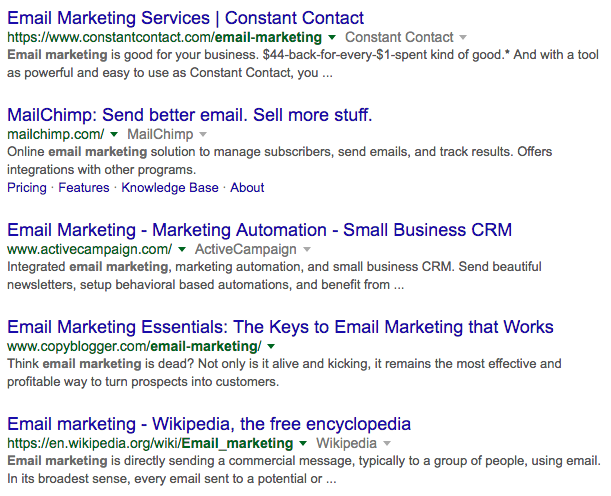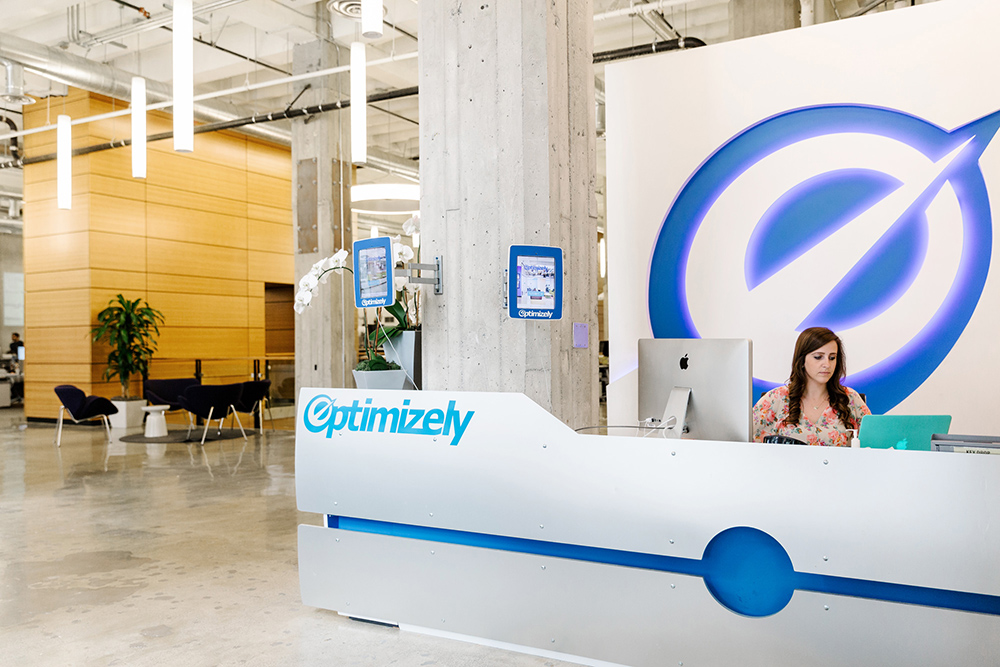5 Quick-Win SEO Opportunities for Software & Technology Websites
Software and technology company websites often have the dual responsibility of explaining and selling their products and explaining (and sometime selling) their niches and solutions. Some of your solutions and/or technology is complicated, but buyers don’t want to invest in something they don’t understand.
At the same time, software and technology industries are innovating at breakneck paces. Between advances in tech, increasing user demands, and stiffening competition, even a tech company marketer needs to be right on top of his/her game.

At first, all of these factors might seem to complicate SEO, but the situation actually provides some great opportunities for quick SEO wins.
The Foundation: User Intent
The truth is, there is not a series of SEO switches you can flip on to just start killing it in organic search. There are some easy fixes and quick tweaks you can perform on your site that will yield some quick gains, but doing those well means they have to be based on a modern SEO framework, which a lot of brands are still figuring out.
Part of that foundation is the fact that keywords are worthless apart from user intent insights. “User intent” is the question behind the query—the meaning behind the characters that a user types into a search engine.
If someone Googles “business intelligence,” for example, does he want information or does he want to make a purchase? Too many brands assume they know what users mean when they search for the brand’s target keywords, and it destroys their SEO efforts.
If your company produces business intelligence software, for example, you might assume that your audience is looking for solutions for their business intelligence. So you create a great sales/product page and optimize it for on-page SEO, but it never ranks well. Why not?
A depersonalized search for, “business intelligence” yields these Page 1 results:

Most of the results on Page 1 represent informative content—definitions, news, etc.—because all of Google’s data indicates that is what users want when they search that term. If your business wants to show up on Page 1 for “business intelligence,” a product page probably isn’t going to get you there, because Google knows users aren’t shopping when they type in that query.
Understanding user intent is the foundation for the kinds of quick win SEO opportunities that will create real, measurable change in your search ranking efforts. (It can also be a very big project, especially for tech companies with a lot of highly specialized terms, which is why a lot of businesses seek experienced, outside help for at least this step.)
1. Create Two Pages for Each Important Keyword
If user intent research indicates that your audience wants information rather than sales information, does that mean you should remove your sales page? What if search results for a keyword produce mixed results?
It is completely okay to create one high-quality, authoritative, optimized, beautiful, helpful, engaging landing page for each prominent user intent per keyword. Each page will have unique content, serve a different purpose, and live on a relevant part of your site.
If “email marketing” is a target keyword, for example, you might Google it and realize that the results are pretty split: there is some informative content and some sales content.

Three “purchase” intents and two “inform” intents in the first five results for “email marketing” is a pretty mixed bag.
So create a page for each. If your company sells email marketing software, create one really thorough page of resource content about what email marketing is and how to do it well. Then, create a really great product page for buyers who are deeper in the funnel.
The good news: a lot of tech companies aren’t doing this yet. Within our “email marketing” example, the publishers producing informative content are Wikipedia and third-party marketing blogs—not vendors. Crash into the space with competitive (branded) content.
2. Create Definition Pages
For many software and technology terms, definitions are a clear intent. You will know this is the case if you Google one of your keywords and you get a featured snippet box at the top of the page with a definition in it—like the “business intelligence” SERP, above.
But wait! No featured snippet does NOT mean it’s not applicable, it just means no one has grabbed it yet. Talk about an opportunity!

The SERP for “cloud security” includes a featured snippet, but it is not a definition. That might mean Google is TRYING to pull some 101-level info for the term, but can’t find a definition.
If you already have, or are developing, a comprehensive resource page for the term, merge your efforts. Make sure the content near the top of the page includes an almost dictionary-like definition of the term in question: “Email marketing is …” Make it comprehensive, but concise.
If you do not have a resource page for the term yet, a simple definition page can be an easier precursor to launch in order to get Google’s attention while you develop something truly epic. Start with that definition statement, include examples as necessary, design the page well, and link to authoritative additional resources—both internally and from other publishers.
3. Improve Page Titles to Earn Clicks
Getting content to rank well is a good start, but it doesn’t really help your business if users don’t click. Consider all the elements that might appear on a modern Google search results page (SERP):
- Up to four sponsored results at the top
- A Knowledge Graph entry in the sidebar
- “Images for” thumbnails
- “In the news” previews
- “People also ask” drop-downs
- Up to three additional sponsored results at the bottom
- “Searches related to” suggestions in the footer
Mixed in with all of Google’s suggestions are ten organic search result links. Each one gets a title, URL, and a meta description with which to compete for clicks—which really isn’t much. The most prominent feature is the page title, so it’s well worth the effort to craft a good one in order to inspire clicks:
- Count characters. We cap our SEO page titles at 55 characters. You can sometimes get away with a few more, but when Google bolds the user’s query term in your title it might truncate anything longer than 55 characters.
- Include the brand name. Those 55 characters need to end with “- Brand Name,” because if you don’t, Google will often add it, cutting off your carefully crafted page title. Just plan for it by including your business’ name.
- Use the keyword at the front. Google will look for the keyword in the page title, and its position in the title tends to correlate with its perceived importance. User experience always trumps technical tactics, though, so don’t make it awkward.
- Include a CTA. Use an action verb, if possible: find, discover, win, book, etc. Mirror the action the user wants to take back to him/her, and you will earn some serious trust points.
- Be different. Google your keyword and look at what other companies are doing—and then do something different. If Page 1 is full of numbered lists, for example (“10 Ways …” “7 Simple Ways …” etc.), don’t do the same thing. In software and tech, this is especially key because a lot of your competition is using industry terms that users don’t understand. Standing out might just mean speaking English.
Of course, you won’t be able to pull off all of these on every title. Treat this list as a guide, not a checklist. Above all, make sure you are speaking to buyers in their language and addressing their needs.
4. Improve Meta Descriptions to Earn Clicks
See the above: SERPs are crowded. While a page title is your first chance to grab a buyer’s attention, the meta description is often what earns the click. If you don’t specify a meta description, Google will pull either the top content, or what it thinks is the most relevant content, from the page. Either solution is not the best one for your SEO efforts.
- Count characters. Shoot for 155. We have seen Google experimenting with longer meta descriptions in some cases, but 155 is a good, safe number for now. If you’re designating a meta for a blog post, the number drops to about 140. This is because Google will add the date, with spaces and a dash, at the beginning, and hold it against your character count.
- Include a value proposition. Why should a decision-maker click on your page over all of the other options he has on a SERP? Focus on the value to the user, rather than the features of your product or service. Don’t tell us what task you can perform, tell us how it will serve the buyer and his/her business.
-
Tease the content. Give away some info so the user knows you have some authority and/or experience, but then entice him/her to click for more. Questions are helpful here: “Is your business ready?” “Do you have a plan?” etc.
If you are using WordPress, the Yoast SEO plugin is a great tool that makes it really easy to specify an SEO title and meta description for every page and post.
5. Make it Fast and Mobile-Friendly
You’ve heard this before, but if your site isn’t mobile-friendly and/or it doesn’t load quickly, it is becoming more and more obsolete every day. The mobile web is growing quickly. Last year, marketers prepared for Mobilegeddon. This year, Google announce a new effort called Accelerated Mobile Pages (AMP). Google is heavily invested in keeping up with users’ shrinking attention spans, and companies that don’t cooperate will quickly find themselves in the dust.

The lightning bolt icon and “AMP” indicate which pages are optimized for Google’s AMP.
Google’s own Mobile-Friendly Test is still a decent tool for checking your site and diagnosing any problems. There’s also an AMP WordPress plugin that will dynamically generate AMP-compatible versions of your content for mobile users.
Not-So-Quick SEO Wins: Write Better Content than the Next Guy
With some quick wins under your belt, it’s time to take a step back and invest in some really revolutionary SEO strategy. The very best SEO work you can do is to create really outstanding content.
There is a huge volume of content online and a daily, relentless flood of new stuff. Quick content will make a small splash and be easily forgotten, but valuable content will earn business results today and in the future. We call this “engagement SEO” work, and find that it is based on content that is:
- The most helpful
- The most popular
- The most engaging

Start by reviewing your existing content: does it provide clear answers and actionable take-aways for the reader? Does it earn shares, likes, and links without your promotion (based entirely on its own merit)? Does it capture the buyers’ attention and inspire them to click through and participate with the content?
This is especially relevant for software and technology providers, because—let’s be honest—some of your niches are complicated and difficult to write about. If you can create great content that helps buyers and decision-makers feel like they actually understand business IT concepts (for example), you will have them hooked.
As your pages climb through the Google rankings, check out the pages that are ranking ahead of yours and look for inspiration and ideas. Don’t copy, though—improve.
Improve SEO This Week
In general, SEO is a long-term strategy and should be treated as such. That doesn’t mean, however, that there isn’t low-hanging fruit, or that you can’t start an SEO campaign with some quick wins.
Set aside a little bit of time to get some solid user intent research completed, and you will have the insights you need to pull off some genuinely effective SEO quickies like titles and metas that speak directly to your audience.
What's Next?
Profound Strategy is on a mission to help growth-minded marketers turn SEO back into a source of predictable, reliable, scalable business results.
Start winning in organic search and turn SEO into your most efficient marketing channel. Subscribe to updates and join the 6,000+ marketing executives and founders that are changing the way they do SEO:
And dig deeper with some of our best content, such as The CMO’s Guide to Modern SEO, Technical SEO: A Decision Maker’s Guide, and A Modern Framework for SEO Work that Matters.




